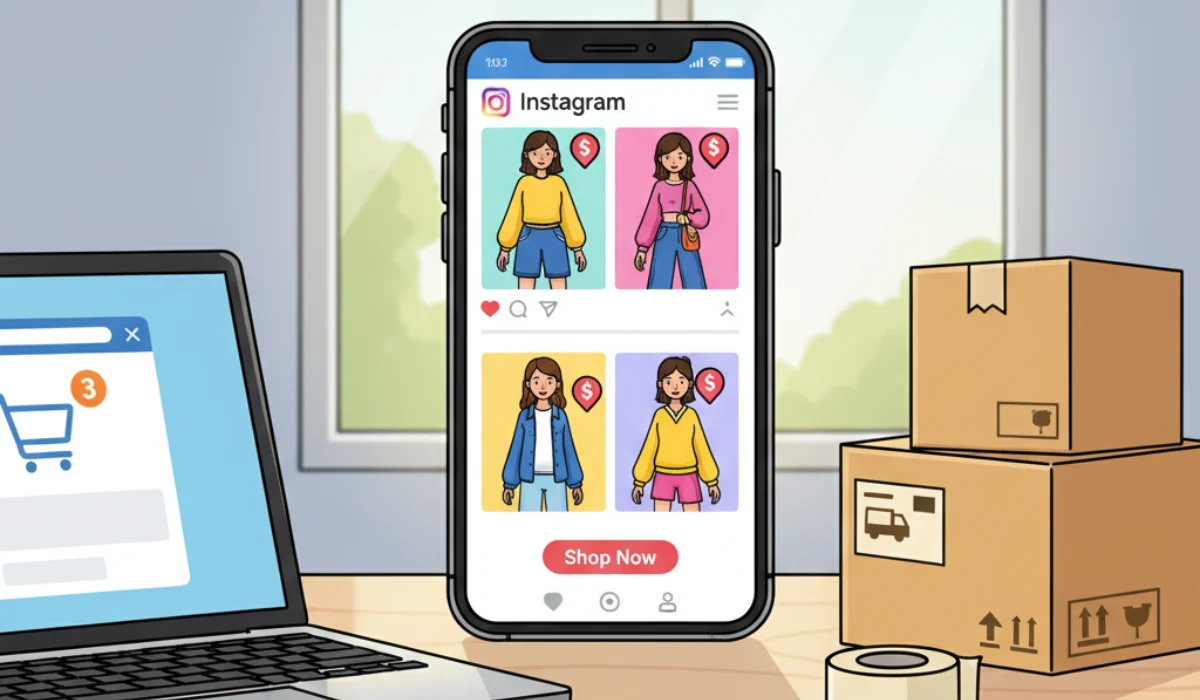Why Instagram Remains a Top Choice for Selling in 202
Instagram's dominance in social commerce stems from its visual-centric design, which aligns perfectly with product showcasing. Launched in 2010, the platform has continually innovated, introducing features like Reels in 2020 and enhanced shopping tools in subsequent years.
By 2025, Instagram's advertising audience has grown to 1.32 billion, as per DataReportal, allowing sellers to target diverse demographics effectively.
One key advantage is its suitability for product discovery. Unlike text-heavy platforms, Instagram enables high-quality images and videos that capture attention instantly. According to a 2025 report from the Social Shepherd, 81% of users research products and services on Instagram, making it ideal for brands in niches ranging from fashion to tech.
Additionally, the platform's global reach caters to various markets; for instance, in the U.S., social commerce sales are projected to exceed $90 billion this year, up from $64.8 billion in 2023, per Sprinklr.
Another factor is Instagram's adaptability to emerging trends. With the integration of AI-driven recommendations and augmented reality try-ons, sellers can provide immersive experiences that boost engagement. However, success hinges on compliance with platform guidelines and adapting to algorithm changes, which prioritize authentic content over overt sales pitches.
As transitional economies recover post-pandemic, Instagram's role in driving small business growth has become even more pronounced, with millions of creators and entrepreneurs leveraging it for revenue.
The Primary Methods to Sell on Instagram
Sellers have two main pathways to monetize on Instagram: directing traffic to an external online store or using the platform's native shopping features. Each method offers distinct benefits and challenges, influencing how beginners approach their strategy.
The recommended approach involves building an independent online store and using Instagram as a promotional channel. This method provides greater control over branding, customer data, and payment processes.
Platforms like Sellfy or Shopify allow quick setup without coding expertise, enabling sellers to customize their storefronts fully. For example, Sellfy reports that users can launch a store in under five minutes, with no transaction fees beyond standard payment gateways.
In contrast, Instagram Shopping integrates directly with the app, allowing product tags in posts, Stories, and Reels. Introduced in 2016 and expanded with Checkout in 2019, this feature lets users buy without leaving the platform.
Data from Shopify's 2025 enterprise blog indicates that Instagram Shopping can reduce purchase friction, potentially increasing conversions by 20-30%. However, it limits sellers to physical products in supported markets, requires a Business account, and imposes eligibility criteria, such as having a connected Facebook Shop.
Choosing between these depends on business scale. For beginners, an external store offers flexibility, avoiding Instagram's restrictions and fees (up to 5% per transaction for Checkout). Transitional strategies often combine both, starting with native tools for testing and shifting to independent platforms for long-term scalability.
Step-by-Step Guide to Setting Up Your Instagram Sales Channel
Establishing a presence on Instagram for sales begins with foundational steps that ensure compliance and efficiency. Below, we outline a practical process based on current best practices as of 2025.
Create or Convert to a Business Account
Start by switching to an Instagram Business account, which unlocks analytics, ad tools, and shopping features. From the app settings, select "Account" and "Switch to Professional Account," choosing "Business."
This step is crucial, as it allows integration with Facebook and access to Insights, which track reach and engagement. According to Hootsuite's 2025 statistics, Business accounts see 1.5 times higher interaction rates than personal profiles.
Build Your Online Store
Opt for user-friendly platforms like Sellfy for beginners. Sign up for a plan—starting at $29/month—and add products via the dashboard. Upload images, descriptions, and set prices. For digital products, Sellfy handles secure delivery, while physical items support shipping integrations.
Connect payment gateways like Stripe or PayPal for seamless transactions. In 2025, with global e-commerce growth at 8.3% per eMarketer, such platforms enable sellers to capture a share of the $924.47 billion social commerce market.
Link Your Store to Instagram
Add your store URL to your bio for easy access. Use link shorteners if needed, and include a call-to-action like "Shop now" with an arrow emoji. Tools like Linktree can manage multiple links, but for direct sales, a single store link suffices. This setup drives traffic effectively, with bio links accounting for 30% of Instagram-driven sales, per Sprout Social data.
Optimize Your Profile for Sales
Craft a compelling bio that highlights your brand and products. Include keywords like "handmade jewelry" for SEO within Instagram search. Use a professional profile picture and highlight reels for product demos. Consistency in branding fosters trust, aligning with Google's E-E-A-T principles for authoritative content.
Integrate Instagram Shopping (Optional)
If eligible, enable Shopping by linking your catalog through Facebook Commerce Manager. Tag products in posts to create shoppable content. However, note that as of 2025, only 70% of markets support Checkout, limiting its global utility.
Crafting Content That Converts Viewers to Buyers
Content is the cornerstone of Instagram sales. Focus on high-quality visuals and strategic posting to engage audiences.
Develop a Content Strategy
Adhere to the 80/20 rule: 80% educational or entertaining content, 20% promotional. This builds loyalty, with engagement rates averaging 0.9% for non-promotional posts, per Rival IQ's 2025 benchmarks. Use transitional content like tutorials that lead to product mentions.
Leverage Reels and Stories
Reels, with 200 billion daily views in 2025 (Meta data), are ideal for short product demos. Stories, viewed by 500 million users daily, support swipe-up links for Business accounts. Incorporate polls and questions to boost interaction, transitioning viewers toward purchases.
Utilize User-Generated Content
Repost customer photos with permission to build social proof. A 2025 Stackla report notes that UGC increases purchase intent by 79%. Encourage submissions via hashtags like #MyBrandStory.
Schedule and Analyze Posts
Use tools like Pallyy for scheduling. Post during peak times—typically 8-10 AM weekdays, per Later's 2025 analysis. Monitor Insights to refine strategies, aiming for 1-3 posts weekly.
Advanced Strategies to Scale Sales
Once basics are in place, scale with ads and partnerships.
Run Targeted Ads
Invest in Instagram Ads via Meta Ads Manager. With a $1.32 billion advertising audience, target by demographics and interests. A/B test creatives to achieve ROIs of 3-5x, as seen in 2025 case studies from Shopify.
Collaborate with Influencers
Partner with micro-influencers (10k-50k followers) for authenticity. Platforms like Aspire facilitate connections, with ROI averaging $5.78 per dollar spent (Influencer Marketing Hub 2025).
Host Giveaways and Promotions
Run contests to grow followers, requiring entries like tags and shares. SweepWidget simplifies management, boosting engagement by 34% on average (2025 data from Gleam).
Measure and Optimize Performance
Track metrics like reach (aim for 10-20% of followers) and conversion rates. Tools like Instagram Insights and Google Analytics help identify top-performing content.
Common Challenges and Solutions
Beginners often face low engagement or algorithm changes. Combat this by posting consistently and engaging with comments promptly. For algorithm shifts, focus on video content, as Reels receive 22% more interactions than static posts in 2025
Conclusion: Thriving in Instagram's E-Commerce Landscape
Selling on Instagram in 2025 demands a blend of creativity and data-driven tactics. By establishing a robust store, crafting engaging content, and leveraging advanced features, sellers can tap into a market where social commerce is set to exceed $1.48 trillion by 2030. Start small, analyze results, and scale strategically to achieve sustainable growth.



